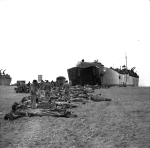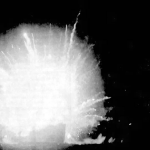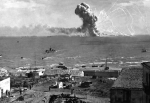NavSource Online: Amphibious Photo Archive
LST-422

LST-422 was transferred to the United Kingdom for the duration of World War II
Please report any broken links or trouble you might come across to the Webmaster. Please take a moment to let us know so that we can correct any problems and make your visit as enjoyable and as informative as possible.

| Click On Image For Full Size Image |
Size | Image Description | Source | |||
|---|---|---|---|---|---|---|

1016042202 |
150k | HM LST-422 beached in the background near St. Teresa, Sicily while Princess Patricia's Canadian Light Infantry troops sleep on the beach at dawn while awaiting transport to Italy, 4 September 1943. | Barry Miller | |||
 |
57k | HM LST-422 along with an unidentified LST being unloaded in Anzio harbour. Photo by Denis Healey, from "Anzio: The Friction of War: Italy and The Battle For Rome 1944," by LLoyd Clark. | Robert Hurst | |||

1016042203 |
89k | On 25 January1944, HM LST-422 departed Naples, Italy, carrying members of the 83rd Chemical Battalion and 68th Coast Artillery Regiment. The ship
also carried vehicles, gasoline and a variety of ammunition, together with ammunition-related volatile chemical equipment. By night, the ship had arrived in the Allied—held harbor of Anzio,
southwest of Rome amid gale force winds. Early in the morning of J26 anuary, the ship drifted into a minefield, striking a submerged mine. The subsequent explosion tore a hole through the
bottom and starboard side of the ship, fire rapidly spread as the gasoline and chemicals on deck were ignited. As the ship flooded and continued to burn, orders were given to abandon ship.
Rough seas complicated rescue attempts by nearby vessels, and many crew members were lost in the frigid waters as the ship broke in two and sank.
USS Pilot War Diary, 1 January-31 January 1944 (Action Report) |
Barry Miller | |||

1016042204 |
174k | |||||
| Back To The Navsource Photo Archives Main Page | Back To The Amphibious Ship Type Index | Back To The Tank Landing Ship (LST) Photo Index |
| Comments, Suggestions, E-mail Webmaster. |
|
This page created and maintained by Gary P. Priolo |